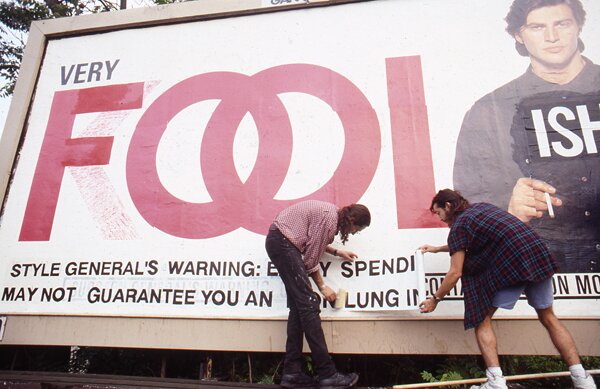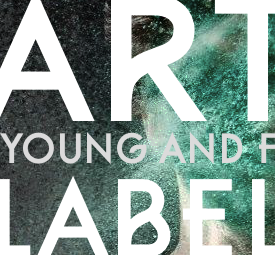Since basing himself in Barcelona in 2002 Jorge Rodríguez Gerada has focussed on his art practice of urban interventions, in different ways, in cities throughout the world. Through community interaction he started to compliment urban surfaces and materials with large-scale ephemeral portraits of anonymous locals in his Identity Series. Rodríguez Gerada further developed this in his Terrestrial Series, with portraits, or mandalas large enough to be seen from space. He continues to experiment with urban materials and the idea of individual identity as his work evolves.
What did you learn and carry forward from your Culture Jamming days?
I think the idea of using what advertising does, which is location, size, something of the idea of the spectacular, to bring attention is something that works. If you can be creative enough and have the energy to pull something like that off on a large scale then you can talk about things that are important to you…That’s why a lot of what I do is usually based on things that I believe in.
What are you working on at the moment?
I am getting ready a body of work for a show that opens in the beginning of October in Paris at the Mathgoth gallery. I’m doing pieces from three different series, one which uses smaller pieces of wall fragments that I work on, another (which uses) larger pieces that are extracted wall surfaces as my base, and..five small sculptures made of French brick. I like to use as much of the architectural visual language from the place as possible.
What is it that your really enjoy in the architecture and Urban materials?
There’s a history behind it, there’s a narrative. When I use these old wall surfaces, I’m actually using wall surfaces that are painted by generations of people. People who painted a wall when their baby was born, or when their mother in law was coming to visit. So all those layers of moments of their happiness is sort of the base of each piece.
What direction is your work now taking?
I love experimenting; my whole idea of giving all the importance possible to the common person is a big thing for me. I think that we can’t lose sight of the individual, the idea of numbers, the idea of statistics.., for me is a disgusting very troubling way of looking at who we are…Every life is important. So, with that said, I really care a lot about the idea of how cities are put together… I’m working on a lot of different things at the same time (for instance); all the materials used from parts of buildings in my art work, (to) going into the idea of scanning faces using an algorithm programme to give you a composite face of the city based on the demographics of that city, to (doing) monumental sculptures… I love feeling how each city has its vibration. This is (also) the fourth year of a thing I curate in Tudela de Navarra, just south of Pamplona, which is called the AvantGuard Urbano Festival..a little urban art festival with big names. Plus.. the next big terrestrial will be done in Belfast.
Will the Terrestrial be of a known person?
No it’ll be of an anonymous child. I love the idea of this honesty and purity that a child’s gaze has, and the fact that I’m going to do this child’s face looking out from Belfast, looking out into the future, from that harbour. And the piece is going to be called Wish. All I’m saying is that it´s important to take into consideration the beauty and innocence of a child´s wish, especially when you put it into the context of a city like Belfast.
And what materials will you use?
The space is green..I’ll probably be able to play with more colours. But it’ll be very large scale; we’re talking about tons of material being moved around. I’d like to get the soil from (different agricultural, ecological local groups) and play with different natural materials from the area.
Rodríguez Gerada’s appreciation of the contemporary city; its layers and structures, architecture, people, history and future is felt in his works where real people meld with the urban fabric, sometimes to graciously fade again. In his large projects it is as much the portraits as the coming together of people to create something in positivity that raises the spirit of the work. On Wish, speaking of its pure message of a child’s ability to wish and hope he said:
“That’s all it is, we have to focus on that, if we don’t focus on that then everything’s lost.”
CULTURE JAMMING
“Culture Jamming is the practice of parodying advertisements and hijacking billboards in order to drastically alter their message”
(No Logo, Klein, pp 280).
In the early ‘90s New York Jorge Rodríguez Gerada and a group of fellow art students, later to become ‘Artfux’, found they could harness the media attention gained from public interventions to give attention to issues they felt were important. Growing up in a poor minority area, Rodríguez Gerada came to resent the public advertising that dominated the public spaces; not only were they an imposition on spaces that should be shared but they also pushed images of unlikely human perfection and brands that did little good, particularly those such as cigarettes and cheap alcohol. Armed with clear goals and guerrilla tactics the group launched “clever/cute” intervention on billboards, using humour to alter the image and statement of these ads to highlight the negative effect of these products. In those public spaces, and with the media attention gained, they provoked dialogue where only a statement had existed. For example, cigarette ads with attractive and cheerful youths were altered to have cigarette stained and aged features; the lucky guy with two beautiful women on his arms now looked comical and decrepit. Instead of the obligatory warning it read ‘ How cool do you look hooked up to an iron lung’.
Thus Culture Jamming became a coherent movement. Yet so great was its success that Culture Jamming’s very ability to undermine those ads became negated. Instead the brands gained more attention, and the advertisers began to Culture Jam their own ads to bring attention to themselves. Whilst the movement’s ability to bring about change was derailed, artists involved continued to use it as a stylistic device for personal attention, without concentrating on what mattered. For these reasons Rodríguez Gerada stepped away from Culture Jamming to become an expansive artist in his own right.
- Share:
- Tweet
- Share on Tumblr








Pingback: FLIC Magazine | Past and nostalgia, the perfect equation for an anniversary